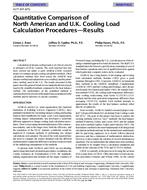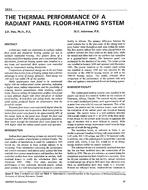Through specific examples, this paper demonstrates the step-by-step application of an indoor air quality procedure to four practical building situations. Along with the occupants, the contaminant sources of interest are building materials and furnishings. This paper discusses the input data and contaminant source information necessary for the application of the procedure and addresses the current availability and adequacy of the data. The usefulness and reliability of the procedure’s application relies on a thorough knowledge of the emission behavior of the sources, a clear definition of the occupant response objectives, and a knowledge of acceptable indoor concentrations. Application of the procedure involves a variety of decisions and judgments that are critical to the outcome of the procedure. The impact of these decisions and judgments is demonstrated. In applying this procedure, it quickly became apparent that an adequate knowledge of the necessary combination of emission characteristics of the material sources and information relating to authoritative acceptable indoor concentrations were not available. The effects of these inadequate source data and the lack of information necessary to make the intervening decisions and judgment calls throughout the procedure are clearly demonstrated. Potential variations in final calculated ventilation rates can be large. As a result, the practical reliability of this procedure and the confidence a designer might have in its conclusions must be questioned.
It is concluded that because of the uncertainty in and unavailability of adequate source data and related occupant response information, use of this procedure for building material sources is impractical as a mainstream engineering practice at this time. The relationship between laboratory measured source data and room ventilation requirements is not clearly understood. More work needs to be done to thoroughly evaluate building and material sources, to understand occupant responses to varying levels of contaminants found in indoor air, and to develop additional guidelines for acceptable occupant exposures before this procedure can offer the reliability required for its commercial application by the building industry.
Authors: James A. Tshudy, Ph.D.
Citation: IAQ and Energy 98: Using ASHRAE Standards 62 and 90.1 Conference Papers
Keywords: October, Louisiana, 1998
Citation: IAQ Conference: IAQ 98
Product Details
- Published:
- 1998
- File Size:
- 1 file , 310 KB
- Product Code(s):
- D-8134


